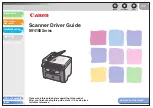
T
T
E
E
C
C
H
H
N
N
I
I
C
C
A
A
L
L
Q
Q
U
U
E
E
S
S
T
T
I
I
O
O
N
N
S
S
A
A
N
N
D
D
A
A
N
N
S
S
W
W
E
E
R
R
S
S
22
T
T
E
E
C
C
H
H
N
N
I
I
C
C
A
A
L
L
Q
Q
U
U
E
E
S
S
T
T
I
I
O
O
N
N
S
S
A
A
N
N
D
D
A
A
N
N
S
S
W
W
E
E
R
R
S
S
W
HICH RESOLUTION FOR WHICH PURPOSE
?
Purpose
Resolution Colour depth
colour picture, print-out
150 dpi
24-48 Bit
greyscale pictures/photos 200 dpi
10-Bit
text recognition
300 dpi
1-Bit
For greater quality requirements, higher values can be set, but
these require far more memory and therefore slow down the
speed of the scanning process.
Text recognition functions optimally with the settings given.
M
EMORY REQUIREMENT FOR DIFFERENT RESOLUTIONS
Scanning an original with an area of 10 x 10 cm uses the follow-
ing amount of memory with the resolution stated:
100 dpi 150 dpi 300 dpi 600 dpi
line picture
19,5 Kb
44 Kb
175 Kb
703 Kb
greyscale
156 Kb
352 Kb
1.37 MB 5.5 MB
colour
469 Kb
1 MB
4.12 MB 16.5 MB
W
HAT DOES THE FOLLOWING MEAN
?
Colour depth Number of colours which can be represented simul-
taneously.
1-Bit = 2^1 = 2 colours = black/ white
8-Bit = 2^8 = 256 colours
16-Bit = 2^16 = 65.536 colours
24-Bit = 2^24 = 16.777.216 colours
Dpi
Unit of resolution, number of
d
ots
p
er
i
nch.
OCR Text
recognition
Pixel Picture
dot
Resolution
The ratio of the pixels (dpi) shown in the area.
TWAIN
Standard – this makes the exchange between the
scanner and the computer possible.



































